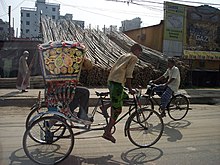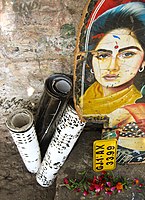Rickshaw art

Rickshaw art or auto art is a form of neo-romanticism emerging in the Indian subcontinent.
The art in question consists of oil paintings on the rear of the canvas roof of rickshaws, done by local street artists, who also paint the various landscape, portraits and personal statements of the driver.
History[]
In Bangladesh, rickshaw art dates back to the 1950s and every conceivable part of the rickshaw is painted. In addition to geometric designs, there are depictions of flowers, birds and even popular actresses. The rickshaw can be decorated to show the driver's religious beliefs and sometimes even a commentary on current social issues.[1] In Bangladesh, rickshaw art is looked down upon by the elite population.[2]
The three-wheeled pedicab, more commonly known as the rickshaw, has been around since the 1940s. Initially, they were undecorated, but starting in the late 1940s, the faces of movie stars began appearing as decorative motifs on shields at the back of the rickshaws along with a variety of floral paintings. The unique trend of rickshaw art started from Rajshahi and Dhaka in Bangladesh and took its own style in each district. For instance, Chittagong being a more pious city then Dhaka mostly had floral or scenery art whereas Comilla has plain rickshaws with beautiful dark blue or green hoods, on which are sewn an appliqué of a minaret or floral design enshrining the word "Allah".[citation needed]
Artwork on the wheels of the rickshaws are done using very bold, bright and raw colours, like fluorescent green, dark red and so on. The blaze of colours also help to make them long lasting.
Author Joanna Kirkpatrick states her definition of rickshaw art:
I consider it "peoples' art". It is not necessary to force it into a unitary category as it combines folkloric, movie, political and commercial imagery and techniques. It serves the expression of heart's desires of the man in the street for women, power, wealth, as well as for religious devotion. Rickshaw art also serves prestige and economic functions for the people who make, use and enjoy it.[3]
Rickshaw art also reflects the economic globalization process, which is occurring all over the world today, for instance those rickshaws with Osama Bin Laden's pictures. Rickshaws are not only painted but also decorated with tassels, tinsel and colourful plastic.[citation needed]
Rickshaw art covers the whole rickshaw decoration, from painted backboards and rear side panels to cut-outs appliquéd on to hoods, as well as brass vases replete with plastic or paper flowers. The painted rectangular metal board at the backside, between the two wheels, leaves a trail of passion that the Rickshaw artist puts in his creations.[4]
This living pop art in Bangladesh is primarily created by illiterate rickshaw artists. They learn their techniques by living with Ustat (masters) from boyhood. They do not have copyrights, and in most cases are not attributed by name on their art. In the back of rickshaws however, there is generally a mark of the maker indicated by a bold steel pin, for example - "Fazlu Mistri". Today, rickshaw art and artists are in a 'struggle of existence'. Third and fourth generations are increasingly less interested in learning the art due to low incomes of two to three dollars a day as well as the lack of recognition.[citation needed]
Biskut Factory[]
As the genre of hand painted objects are dying down due to screen printing and other such technologies, a Bangladeshi artist called Biskut Abir, started his own art firm called Biskut Factory where he brought back rickshaw art and promoted it by hand painting on modern, innovative products. He uses patterns and colors from Rickshaw art and paints these vibrant images on sunglasses, clothes, shoes, phone cases and almost anything with a surface. His establishment is built on an artsy spirit and his love for rebelling against the system. Biskut lacks an academic background on designing or art, but has quite successfully proven that they can be redundant when talent persists.
By selling and advertising his eye catching art through social media, Biskut has been extremely successful in amusing the youth and bringing back rickshaw art with a twist of modern art.
Gallery[]

A hand-painted decorated rickshaw from Bangladesh

Bollywood actress Smita Patil depicted on an interior decoration from a rickshaw in Mumbai
See also[]
| Wikimedia Commons has media related to Rickshaw art. |
References[]
- ^ RickshawArt.org Website of the social entreprise RickshawArt in Bangladesh. Archived 2017-04-22 at the Wayback Machine Dhaka.
- ^ Marshall Cavendish Corporation (2007). World and Its Peoples: Eastern and Southern Asia. Marshall Cavendish. p. 479. ISBN 0-7614-7631-8. Retrieved March 6, 2010.
- ^ Joanna Kirkpatrick. Rickshaw Art in Bangladesh. Asian Art.
- ^ RickshawArt.org Website of the social entreprise RickshawArt in Bangladesh. Archived 2017-04-22 at the Wayback Machine Dhaka.
Bibliography[]
- Kuntala Lahiri-Dutt and David Williams. (2010). Moving Pictures: The Rickshaw Art of Bangladesh. Ahmedabad: Mapin Books.
- Visual arts media
- Indian painting
- Pakistani painting
- Arts in India
- Arts in Bangladesh
- Arts in Pakistan
- Bangladeshi painting
- Human-powered vehicles
- Decorated vehicles
- Rickshaws
- Transport culture of India

